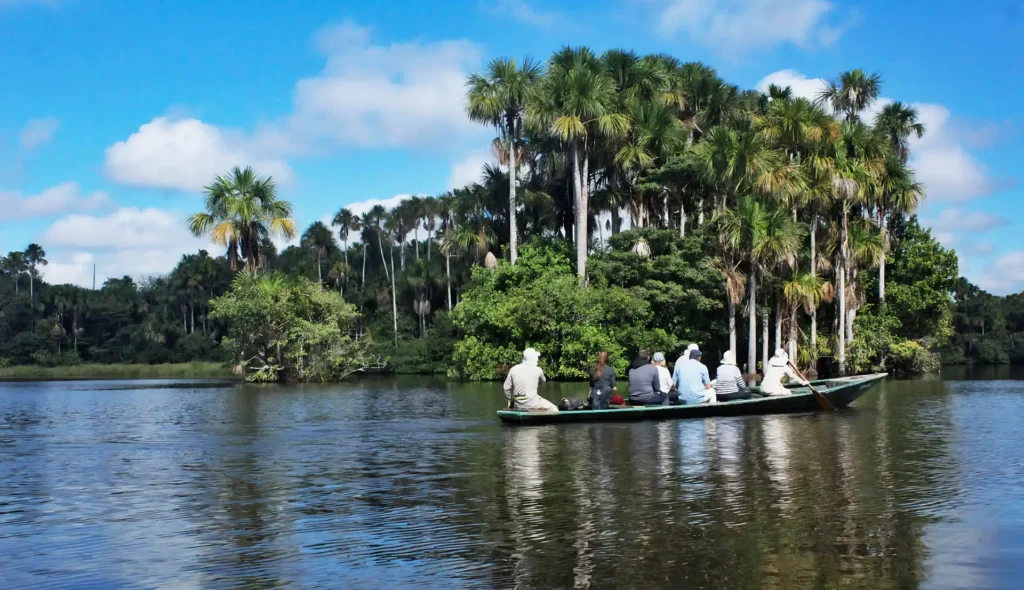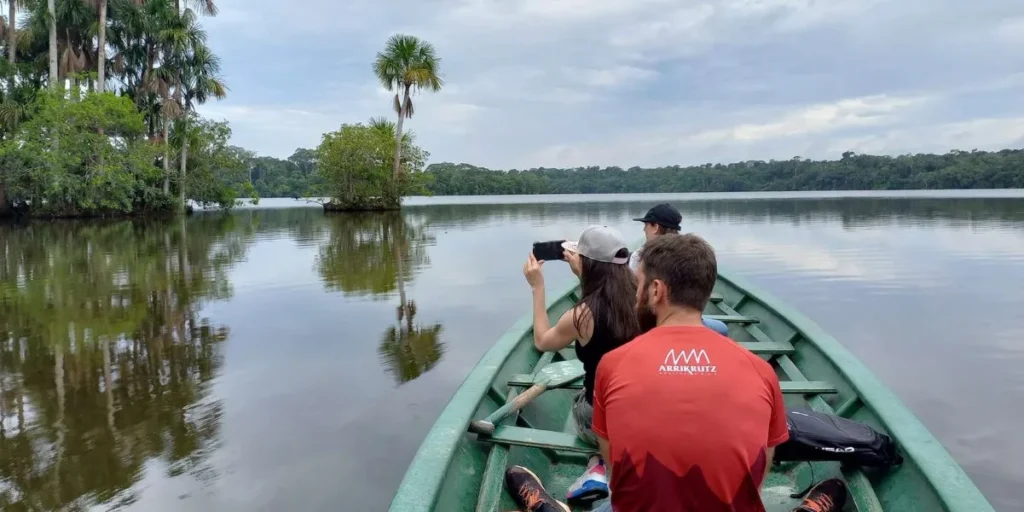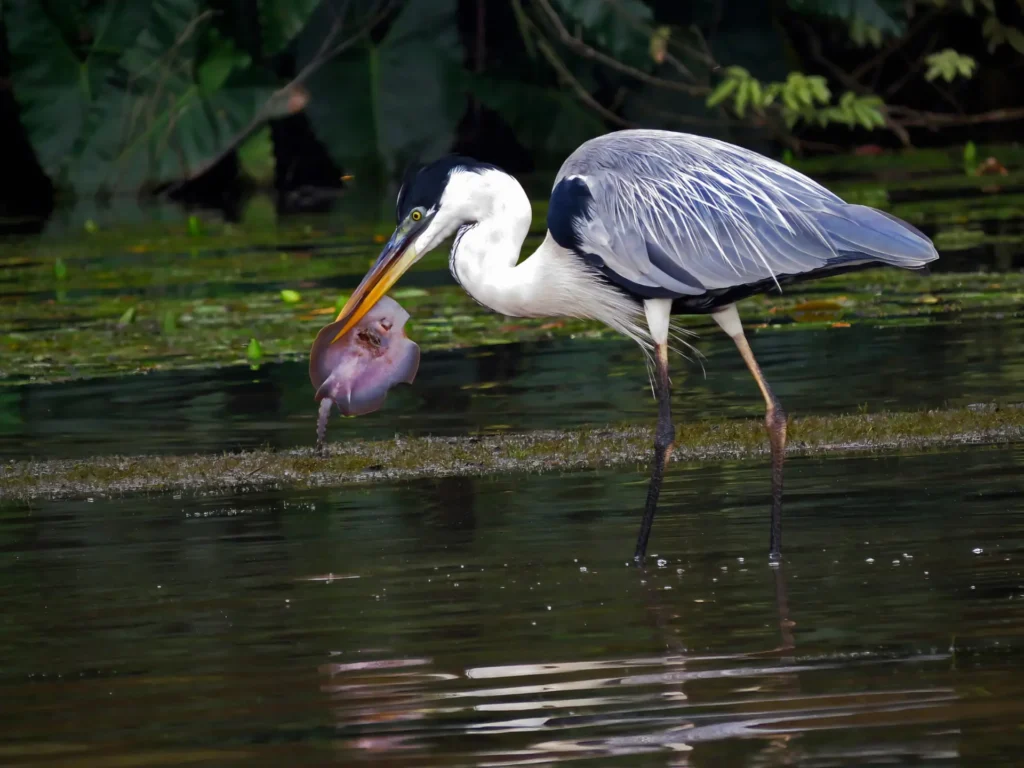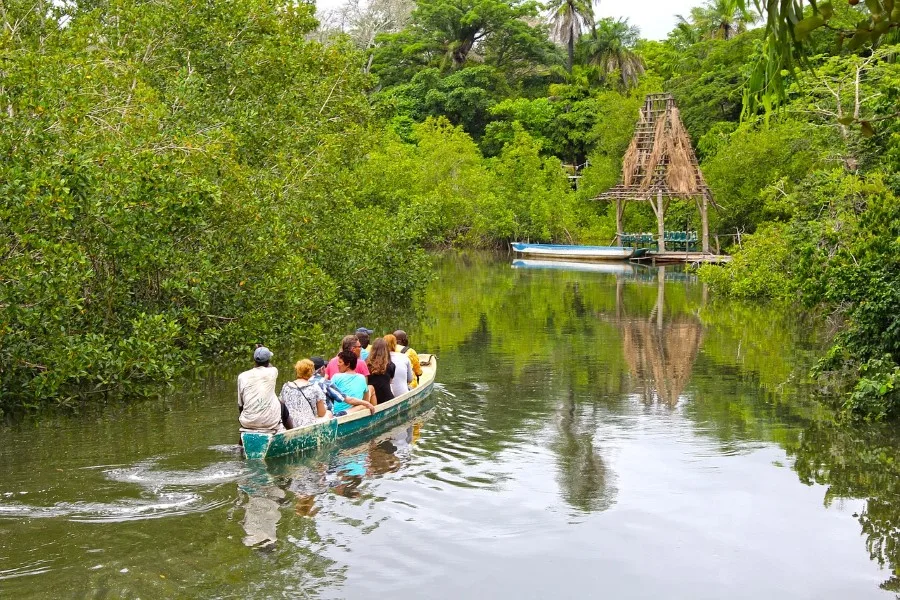In this Travel Guide to the Tambopata National Reserve, we tell you everything you need to know about this impressive natural destination, considered one of the places with the greatest biodiversity on the planet. Here you will find essential information to plan your visit, including where this reserve is located, how to get there from Lima or Cusco, the best activities such as macaw watching or boat rides on the Tambopata River, information about its incredible wildlife (monkeys, caimans, harpy eagles, jaguars) and useful tips for visitors. The Tambopata National Reserve is a unique destination, with one of the most biodiverse rainforests on the planet. Every visitor is amazed by the boat rides along its rivers, the walks among gigantic trees, and the wildlife observation.
Where is the Tambopata National Reserve?
The Tambopata National Reserve is a protected natural area located in the department of Madre de Dios, in the province of Tambopata. It was established in the year 2000 and encompasses vast areas of Amazonian tropical rainforest. Its average altitude, ranging between 200 and 400 meters above sea level, avoids the effects of altitude sickness.
The reserve protects various ecosystems such as bamboo forests, palm groves, and oxbow lakes (horseshoe-shaped lakes). When visiting Tambopata, travelers immerse themselves in a tropical rainforest environment that is almost virgin. With an area of 274,000 hectares, this protected zone is home to a huge diversity of flora and fauna species.

How to get to the Tambopata National Reserve?
The fastest way to get to Tambopata is by flying from Lima to Puerto Maldonado, with an approximate flight time of 1 hour and 20 minutes. From Cusco, it is also possible to travel by road (about 12 hours) or take a direct flight. Once in Puerto Maldonado, the only access is by river, which means continuing the journey by boat along the river. For example, to reach the Sandoval sector, a boat ride of approximately 30 minutes is required, followed by a 3 km walk.
Other sectors of the reserve, such as Alto Tambopata, are reached after 3 to 5 hours of navigation on the Tambopata River. In Puerto Maldonado, there are taxis, cars, and pickup trucks available to transport you to the boarding docks. It is important to note that entry to the Tambopata Reserve is only possible through a tour with authorized guides, which is mandatory for all visitors.

Activities in the Tambopata National Reserve
This Travel Guide to the Tambopata National Reserve will also help you discover the best activities to connect with nature in one of the most biodiverse places on the planet. The jungle offers unforgettable experiences for travelers who love adventure, photography, and wildlife.
One of the most exciting activities is the boat ride on the Tambopata River, where it is common to see caimans sunbathing on the riverbanks. Many tours also include visits to Sandoval Lake, where you can swim in its warm waters and paddle around in a canoe. Here, it is common to spot giant otters, numerous birds, and capybaras in their natural habitat.
Some of the main activities are:
- Walk to Sandoval Lake: a walk of approximately 1 hour to enter the Tambopata National Reserve from the port to the lodge.
- Walk along Amazonian trails: a guided tour to observe flora, ancient trees, and birds such as the harpy eagle, parrots, and macaws.
- Night boat ride: an evening navigation to observe caimans in their natural habitat, identifiable by their bright red eyes.
- Observation at the palm lick: an early morning visit to a site where macaws and parrots feed on dry palm trees rich in minerals.
- Amazonian wildlife spotting: a walk to observe animals such as monkeys, deer, wild pigs, tapirs, and sloths.
- Swimming in Sandoval Lake: a safe activity to swim in the lake, surrounded by nature.
- Sunset canoe ride: a paddle trip around Sandoval Lake to admire the full view and the sunset.
- Piranha fishing: fishing in a small Amazonian river with the option to cook the catch at the lodge.
- Walk to the canopy circuit and zipline: a 15-minute walk through the forest to a 27-meter tower to begin the adventure activity.
- Canopy walk (hanging bridge): crossing a bridge 89 meters long and 37 meters high, among the treetops of ancient trees.
- Zipline: gliding 190 meters over the jungle, with safety gear and professional assistance.
- Optional night walk: a guided activity to explore the jungle at night and experience its nocturnal biodiversity.
- Farewell toast: a social moment after dinner to share stories and close the experience as a group.
- Visit to the Puerto Maldonado market: free time to explore the main market and buy local handicrafts.
- Swimming pool at the facilities: an option to relax by swimming before returning, in the agency’s facilities.

The best time to visit the Tambopata National Reserve
If you are planning your trip to the Peruvian Amazon, this Travel Guide to the Tambopata National Reserve will guide you on the best time to discover this natural wonder. According to experts, the dry season, from May to October, is ideal for enjoying the trails and spotting animals more easily. During these months, the paths are more accessible, and there are more opportunities to see wildlife, since the rains are less frequent.
On the other hand, the rainy season, from December to March, is characterized by heavy showers and fewer tourists. Still, the vegetation reaches its greenest and most lush state. The climate in the area is humid tropical all year round, with temperatures ranging between 15°C in the morning and 35°C in the afternoon. It is recommended to bring lightweight cotton clothing and at least one warm garment for cool mornings.
Wildlife and biodiversity of the Tambopata National Reserve
The Tambopata Reserve is home to extraordinary diversity. There are more than 600 bird species and at least 169 mammal species. Among the most iconic animals are giant otters, capuchin monkeys, tapirs, deer, and the majestic harpy eagle.
Jaguars, ocelots, and anacondas also inhabit the region, along with reptiles, amphibians, fish, and butterflies. Every trail and oxbow lake offers excellent wildlife viewing opportunities. Seeing macaws, toucans, or a sloth in the trees is common. Tambopata is without a doubt one of the most biodiverse places in the Peruvian Amazon.

Tips and recommendations for visiting the Tambopata National Reserve
In this Travel Guide to the Tambopata National Reserve, you will find key information to ensure your experience is safe, comfortable, and respectful of the environment. Before you go, it is important to consider some fundamental aspects to make the most of this Amazonian paradise.
- Certified guide: Entering with a reliable agency is mandatory. It is recommended to choose a trustworthy agency such as Travel Peru Agency, which offers bilingual guides and complete transportation from the airport.
- Vaccines and health: Consult your doctor. Vaccines against typhoid fever, hepatitis, polio, and yellow fever are recommended. Bring strong insect repellent and consider malaria pills.
- Clothing and equipment: Wear long-sleeved cotton clothing, long pants, and field boots. Bring a raincoat, flashlight, camera, binoculars, and a reusable water bottle.
- Respect nature: Single-use plastics are not allowed. Do not touch or feed the animals. Do not remove plants. Follow the guide’s instructions to protect biodiversity.
- Money and communication: Bring cash. Cell phone signal is limited or non-existent in the reserve. Have a copy of your passport.
- Safety: Tambopata is safe for tourism if you follow the rules. Always travel in a group and avoid going out alone at night.
- Plan ahead: Book your tour in advance, especially in high season. Travel Peru Agency offers all-inclusive packages of 3 to 4 days with eco-lodge accommodation inside the reserve.
Frequently Asked Questions about the Trip to the Tambopata National Reserve

1. How do I get to the Tambopata National Reserve?
The most common route is to fly to Puerto Maldonado, from Lima (1h 40min flight) or Cusco (3–4 hours with a layover). Upon arrival, you are usually picked up at the airport, take a short land transfer to the dock, and then ride a boat upriver to your lodge, which can take between 1 and 4 hours, depending on the distance.
There is also the option to go by 4×4 vehicle from Puerto Maldonado via the Interoceanic Highway (about 2 hours) to a river port, from where you will continue by boat. In summary: plane + bus + boat is the standard combination to reach Tambopata.
2. What is the best time of year to see wildlife and macaws in the Tambopata National Reserve?
The best time overall is the dry season (April to November) since the weather is more stable, the trails are accessible, and it is easier to spot animals because there are no heavy rains or flooding. If you’re particularly interested in seeing macaws nesting and enjoying a greener landscape, consider the rainy season (December to March); although some activities might be canceled due to bad weather, the jungle becomes more vibrant and birds gather at the clay licks (collpas). In reality, each season offers a unique experience in the rainforest.
3. What animals can be seen in the Tambopata National Reserve?
If you’re reading this Travel Guide to the Tambopata National Reserve, you’re probably excited about the incredible variety of wildlife you can find in this natural sanctuary. Tambopata is home to one of the most diverse faunas in the world, making it a paradise for wildlife lovers. You can see monkeys (squirrel monkeys, howler monkeys, spider monkeys), colorful macaws, toucans, sloths, and in the rivers, giant river otters, black caimans, and even Amazon pink dolphins. There are also jaguars and pumas, although they are difficult to spot. Additionally, you may encounter poison dart frogs, boas, anacondas in swampy areas, and a huge variety of tropical insects. It is ideal to bring a good camera and be patient, since wildlife is abundant but often discreet.
4. Do I need a guide or can I visit the Tambopata National Reserve on my own?
To enter the Tambopata National Reserve, it is mandatory to have an authorized guide, as free entry is not allowed due to the size and complexity of the area. The best option is to book a tour with a guide or an all-inclusive package, which not only ensures your safety and the organization of your trip, but also contributes to the conservation of the ecosystem and supports local communities. Guides will show you the best spots to observe wildlife, explain the natural environment, and ensure a safe and enriching experience.
5. What equipment should I bring when visiting the Tambopata National Reserve?
It is essential to bring insect repellent, sunscreen, a hat or cap, and light long-sleeve clothing to protect yourself from the sun and mosquitoes. You should also bring comfortable boots or sneakers, a raincoat or poncho, a headlamp with batteries, and a small backpack for daily outings. Don’t forget your camera with a telephoto lens, binoculars, chargers, and cash in small bills, as many areas do not accept credit cards. Lastly, make sure to have your yellow fever vaccination certificate, as it is a mandatory requirement for entering the jungle.

All activities in Tambopata promote ecotourism and the conservation of nature. With this Travel Guide to the Tambopata National Reserve, you are now ready to experience an unforgettable adventure in the heart of the Peruvian Amazon. Contact us and book your trip to the Tambopata National Reserve.
